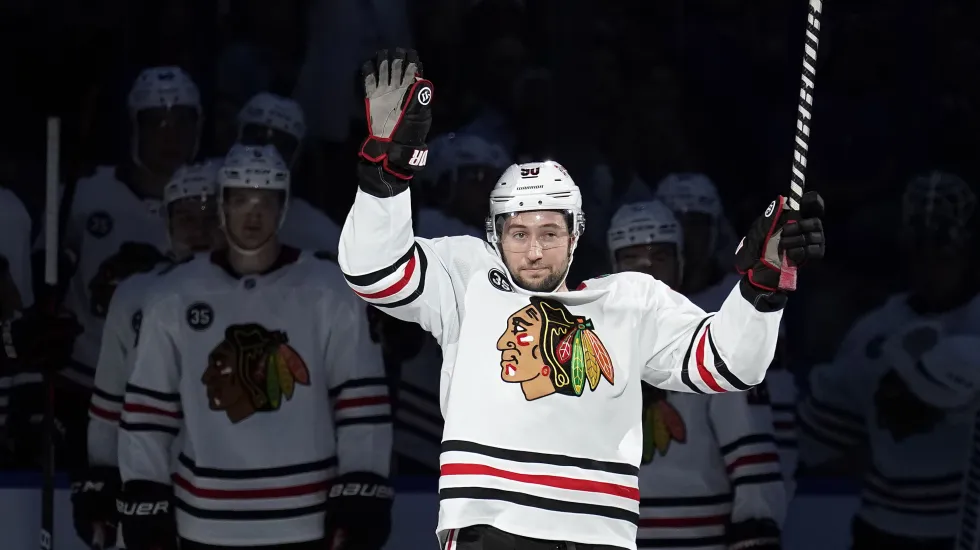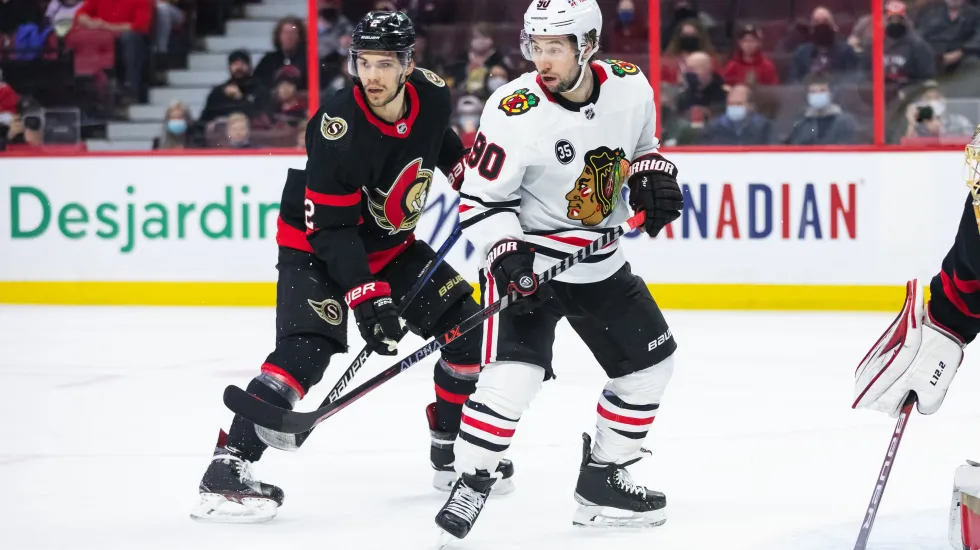
Tyler Johnson is playing professional hockey, healthy and unobstructed, with an artificial disc in his neck.
Jack Eichel is, too.
A year ago, no NHL player had ever received an artificial disc replacement. ADR, as it’s commonly known, was at the time largely considered — in hockey circles — a taboo alternative to fusion.
Now, two NHL players have proved its effectiveness and safety, opening the door for generations of future players to consider it a viable option.
Eichel, the Sabres-turned-Golden Knights forward whose adamance forced the door open inch by inch, and Johnson, the Blackhawks forward whose open mind ensured the door will never close again, deserve immense credit.
So do dozens of others — from Dr. Chad Prusmack, who performed Eichel’s ADR, to Dr. Robert Bray, who performed Johnson’s ADR, to Pat Brisson, the agent who represented Eichel and Johnson through the process — who played roles in hockey’s biggest medical drama in decades.
This is the inside story of how the drama unfolded, where it led and what legacy it’ll leave behind.
What is ADR?
Between every vertebrae in the human spine lies a disc. If a disc herniates or collapses, the vertebrae can ride against each other and affect nearby nerves, causing pain and weakness and often requiring surgery.
Fusion surgeries, which require patients to spend months afterward wearing a collar and to wait a year or more before returning to normal activity, are the most common.
But since their introduction in the U.S. in 2000, ADR surgeries have emerged as appealing and safe alternatives in specific herniated-disc cases. The artificial disc — made of either metal, plastic or a combination of the two — functions like a normal disc, preserving a greater range of motion and necessitating a much shorter recovery time.
“It had been done in European hockey players,” Bray said. “It had been done in rugby and wrestling. I’ve put them in a whole pile of people that are doing all types of extreme sports. ... But [NHL] hockey had not yet jumped that barrier.”

That was partially because disc injuries are surprisingly rare in hockey, partially because athletes often shy away from surgeries and partially because ADR is only an option when several criteria are met. The patient can’t have any ligament instability surrounding their herniated disc — which would allow the artificial disc to move too much — or any fractures or injuries to the surrounding vertebrae themselves, Bray said.
The faster recovery time and greater range of motion are ADR’s biggest benefits, but it also avoids “adjacent-level syndrome” — a common issue after fusions in which the discs above and below suffer wear and tear over time, Bray said.
And if an ADR doesn’t work, a patient can then get a fusion. But the patient can’t go in the opposite direction.
Eichel pioneers
Eichel had been stuck in limbo for five months already — after suffering his initial neck injury in early March 2021 — when he switched agents to Brisson last August.
At that point, the ADR debate and the -Sabres’ staunch opposition to the procedure — which prompted Eichel to request a trade that hadn’t come to fruition over the summer — had been generating plenty of headlines and gossip for months.
“I was skeptical, like most people when they first look at [ADR],” Brisson said. “But once I started diving in and finding out other opinions around the world, I said, ‘Wait a minute, if it works for a skydiver, or a fighter pilot, or a motocross [rider], or a surfer, this could work in hockey, as well.’ ”
Behind the scenes, gears were turning. Eichel and his father had met with Dr. Frank Cammisa, who heads the spine service at New York’s Hospital for Special Surgery and who helped bring ADR to the U.S.
Cammisa then talked to the Sabres’ doctors and began working with the NHL Players’ Association, led by newly named chief medical consultant Scott Delaney.
“We went back to some of the original work we did, in terms of the mechanics and results and what kinds of athletes have gotten it over the years,” Cammisa said. “It hadn’t been done [before], but I came to the conclusion with that data that it was reasonable in a hockey player to do a disc replacement. I spoke to the league about the reasons why, and I wrote a report.”

Eichel had also met with Prusmack, Bray, Dr. Mark Lindsay — a renowned soft-tissue specialist in North Carolina with whom Eichel eventually spent his recovery months — and other “highly recommended” doctors, Brisson said.
“Pat Brisson, he went to bat,” Bray said. “I can’t tell you how many phone calls I had with the two of them over months. Probably 40 hours of phone calls and dozens of letters.”
Mounting pressure around the league eventually forced the Sabres to trade Eichel in early November to the Golden Knights. The Knights supported the surgery and allowed Eichel to undergo it promptly with Prusmack, who inserted a “Secure-C” type of artificial disc on Nov. 12 in Colorado.
“There were doctors that were against it, but we felt comfortable with the right doctors who were in favor and were very comfortable with the process and the type of surgery,” Brisson said. “I give Jack Eichel a lot of credit. He was pretty stubborn about, ‘This is the only way I’m going to get this done. I’m not getting the fusion.’”
Johnson’s journey
Neck pain had been part of Johnson’s life since 2017 or 2018, when an injury while playing for the Lightning likely first aggravated the disc that eventually needed to be replaced. The pain was only present sometimes, and he convinced himself it wasn’t important.
During one of his three preseason games for the Hawks in October, a hit from behind aggravated the injury again, and his “whole arm went numb for about a day,” he said.
Then came the Hawks-Hurricanes game on Oct. 29, Johnson’s eighth appearance of the regular season. A cross-check from Vincent Trocheck during the second period — which left Johnson hustling to the locker room in intense pain — collapsed the disc for good.
His arm was numb for days. Even once the numbness subsided, his arm strength was gone. Conservative treatments, like epidural shots and physical therapy, proved futile.
“I haven’t felt that before where I literally couldn’t move it at all,” Johnson said. “It was pretty messed up. ... I was skating a little bit because I was just trying to get back, and I remember I couldn’t even stickhandle because my arm hurt so bad.”
The options became clear: He could consider either a fusion, an ADR or a cervical foraminotomy, an operation to relieve spinal nerve pressure that Peyton Manning had tried (and failed with) before undergoing a fusion in 2011.
Fortunately, Johnson is represented by J.P. Barry, a CAA Sports colleague of Brisson’s. That connection allowed Johnson to quickly link up with Brisson and then Eichel.
“Originally, the doctor here [in Chicago] did tell me he thought a fusion would be best, just because he didn’t really like the ADR,” Johnson said. “Once I talked to my agent, he said, ‘Hey, I want you to talk to Jack. Jack has gone through this.’ So [Jack] called me. We talked a little bit and texted a few times, here and there, up until I made the decision.”
Added Brisson: “Long story short, Tyler felt comfortable with it because Jack also felt comfortable with it.”
While Eichel had chosen Prusmack for his operation, Johnson felt most comfortable with Bray — who had actually performed a different surgery on Brisson years before — after gathering the necessary range of medical opinions. Johnson credited Bray for making the options easy to understand, with no “mumbo-jumbo” included.
The Hawks fully supported Johnson’s decision, too, to everyone’s relief.
“Credit to them, [the Hawks] were very open and very understanding,” Bray said. “They asked me to communicate with the team doctor and team therapist, which I did, but they were 100% supportive. There was no argument on their part. They just said, ‘We want to see him better.’”

The surgery was scheduled for Dec. 3 at the DISC Sports & Spine Center in California to insert an M6-C type of artificial disc, a different type than Eichel received. Once Bray opened up Johnson’s neck, he was even more relieved he’d chosen ADR.
“It was riding bone-to-bone and creating an inflammatory reaction,” Bray said. “Even between the time the studies were done and when I saw him, [the disc] had been collapsing more and more, and he was having more pain and losing more function.
“As is not uncommon in discs, when they give up, they give up. That disc was gone. There was no chance for it on his own. He needed it done just for his own protection.”
After the operation, the recovery process went so swiftly and smoothly that even Johnson was amazed.
He was up and walking — or a least “waddling around,” as he described it — 15 minutes after waking up. He went out to dinner with his dad the day after surgery. He flew three days after surgery. He didn’t need the prescribed painkillers, only some of the muscle relaxers.
“I started riding a bike about five days after surgery,” Johnson said. “You couldn’t lift anything for two weeks or something, so I was just riding the bike, doing little things. It was a week or nine days after surgery I started skating, [which was] pretty crazy. And then after that, I ramped things up. Right about seven weeks, I was pretty much doing full-tempo stuff.”
By Feb. 8, barely two months post-surgery, Johnson resumed full participation in Hawks practices. And on March 3, exactly three months after the surgery, he returned to game action, playing 11:10 in the Hawks’ overtime win against the Oilers.
Legacy
Even after his successful ADR recovery, Johnson’s spring with the Hawks hasn’t been what he hoped it would be. Rusty on the ice, unfamiliar with his teammates and plagued by a concussion that cost him another two-plus weeks of action, he has recorded zero points in 10 appearances since returning.
But at least he’s playing hockey. At least he’s living a normal life. Without ADR, neither of those would’ve been fathomable.
“You’ve got to weigh all the pros and cons,” he said. “But if any player ever asked me, ‘Are you happy with the surgery?’ [I’d say], ‘I’m 100% happy.’ I can’t even imagine if I [went with the] fusion. I’d still be ... unable to do nearly what I’m doing. So it’s really nice.”
Looking at the big picture, Bray and Cammisa emphasize the breakthrough shouldn’t be overdramatized. The operation still entails some risks and still remains viable for only a limited range of injuries.
“Now there’s a precedent,” Cammisa said. “Hopefully they’ll continue to have great careers. But any reasonable surgeon will tell any player that comes in, ‘Listen, it’s not designed for everybody.’ ”
Nonetheless, Eichel and Johnson’s bravery and resilience — putting their careers and future earnings on the line to push back against the grain — has permanently changed the way the NHL views ADR.
In the future, whenever a player suffers an injury that falls within that limited range, he’ll be free to consider disc replacement without fear of controversy.
“We’ve got to have Mother Nature, time and other players [cooperate], but right now we’re batting 1.000 on artificial discs,” Bray said. “It has opened up a whole new world for these athletes who get injured. [They] have the potential to go back within three months.
“The important thing is it allows the player the choice. And that’s the way it should be. It’s their body.”







